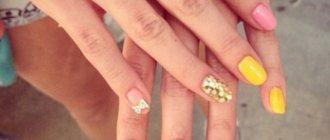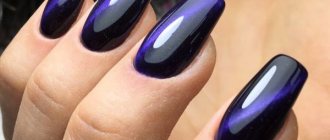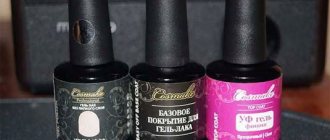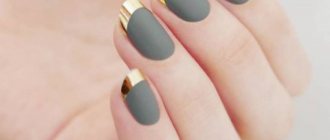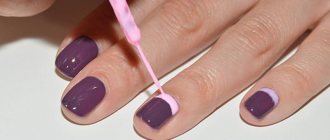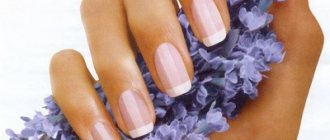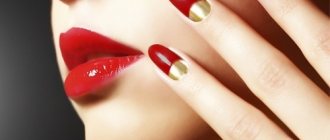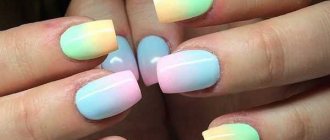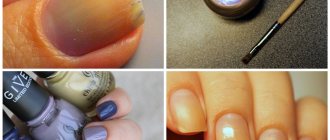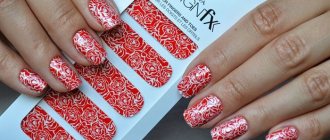The quality of nail extensions or design begins with the correct selection of products that will be applied to the nails at each stage of the extension process.
Artificial modeling of nail plates or their modern decoration, in addition to the basic ones, involves the use of many special additional preparations, such as a degreaser, primer, bonder, dehydrator and others. The desire to save money on them can lead to poor-quality manicure work.
Why degrease your nails?
Using a degreaser
Before you start extensions or design, you need to prepare the nail, remove particles of sebum, dust, and food debris from it. This is necessary so that the adhesion to the gel is subsequently flawless. If you don't degrease the nail plate well enough, the entire manicure can peel off very quickly.
To perform this function, manicurists use a special liquid - degreaser .
After degreasing the surface of the nail, do not touch it with your fingers! This will leave a microscopic greasy trace, and the degreasing effect will be neutralized.
Degreaser and dehydrator
Nail dehydrator
A degreaser is sometimes confused with a dehydrator . But these are two completely different means, each of which has its own tasks.
The dehydrator is designed to remove any unnecessary moisture from the nail plate , not only from its surface, but also from deep. Water left under artificial turf can ruin not only the master’s work, but also the nail.
To avoid troubles, it is not recommended to take baths or use moisturizing creams or oils before artificial extensions: the nail plate must be dry .
Primer and bonder
Primer and bonder
The next pair of terms that confuse inexperienced fashionistas: primer and bonder . These funds also have nothing in common with each other.
To make the adhesion between the microscales of the nail and the polymer material of the future coating stronger, of primer : acidic and acid-free . It is applied after a dehydrator and degreaser. It is quite an aggressive product, so avoid getting it on your skin.
A tool intended for fastening, adhesion, and tying together layers during the modeling process is called a bonder or bond (from the English verb to bond).
The difference between a degreaser and similar products
Thus, the degreaser has no analogues: all of the listed products have their own functions, as well as their own order of application. Below is a summary table of the properties of these tools:
| Degreaser | Dehydrator | Primer | Bonder, bond |
| Dissolves fat | Dries the nail surface | Raises microscopic scales | Strengthens adhesion between layers |
| Removes possible food residues | Removes excess moisture from the nail thickness | Removes residual grease and moisture | |
| Removes dirt and dust |
Best nail dehydrators
Products in this category are suitable for both professional and home use. Dehydrators remove moisture from the surface of the nail, but do not destroy its layers. Primers are most popular among craftsmen who do shellac and gel modeling.
MILV Nail Prep
A Russian-made degreaser for gel polish is designed for short-term dehydration and deep cleaning of the surface. The covering can be worn for up to 7-8 weeks. The primer is used before applying any type of artificial material. The cost of a 16 ml bottle is 170 rubles.
Advantages:
- transparent bottle - you can determine in advance that the drug will soon run out;
- with antibacterial effect.
Flaws:
- the brush is uncomfortable and moves away when applied;
- According to reviews, it does not always fulfill its functions.
Kodi Professional Nail fresher
A degreaser for cleansing and dehydrating the nail acts superficially, without penetrating into the deep layers of the nail plate, and therefore does not destroy its structure. The dehydrator is applied before any artificial turf, significantly extending the wear period. Price – 450 rub. (15 ml) and 1 thousand rubles. (160 ml).
Advantages:
- does not cause allergies;
- dries quickly and well;
- Convenient brush in a small bottle.
Flaws:
- expensive;
- When used professionally, it is quickly consumed.
Patrisa Nail Nail Prep
Powerful dehydrator contains ethyl acetate, isobutyl acetate, isopropyl, no dyes or fragrances. The product removes moisture from the natural nail plate and degreases it. It is used before applying any artificial coating in one layer. Dries on its own in 20-30 seconds. Cost – 170 rub. (8 ml) and 270 rub. (16 ml).
Advantages:
- prolongs the durability of the coating;
- dries quickly;
- does not cause allergies or irritation;
- acts superficially.
Flaws:
- uncomfortable brush;
- After application, you still need to use a primer.
Sophin UltraBond Primer
A German-made nail degreaser improves the adhesion of the natural plate to any artificial materials and prevents coatings from peeling off. The dehydrator does not contain acids, therefore it is safe for the body. The product is applied to prepared nails, dries in 20 seconds, leaving the surface slightly sticky. The price of a 12 ml bottle is 430 rubles.
- Salad with pickles: recipes with photos
- Home treatment for complex, myopic and mixed eye astigmatism
- Gout - what it is, how to treat it
Advantages:
- easy to apply;
- works effectively;
- does not spoil nails;
- long shelf life;
- Convenient bottle, does not slip out of your hands, screws tightly.
Flaws:
- the brush is uncomfortable, splits into two parts, the bristles fall out;
- due to the dark bottle it is impossible to control consumption;
- After this drug, the coating is very difficult to remove; you have to cut it off.
Composition of nail degreaser
Select the appropriate volume of degreaser
Only alcohols can dissolve fat efficiently without causing damage to living tissue. Therefore, the degreaser is based on isopropyl alcohol and ethyl acetate . May contain methyl ethyl ketone for better dissolution and increased volatile properties, which ensures quick drying.
In addition, for additional care of the plate, plant extracts and vitamins . The presence of oil components is excluded. This is why ordinary nail polish remover is not suitable as a degreaser - there are always oil additives to nourish the nail plate and give it elasticity.
Why is isopropyl alcohol the best base for a degreaser? It is easily mixed with water components in any ratio and has excellent disinfectant properties.
The degreaser looks the same as clear varnish: it is a transparent liquid.
Effect of a degreaser: what procedures is it used for?
The degreaser is used for all types of manicure where the master uses an artificial coating: when applying gel polish, shellac, gel extensions .
In addition to preparing the nail plate with a degreaser, remove the sticky layer of gel , and also wash the brushes after extensions, wipe the reflectors of the UF lamp and its other parts. The degreaser acts as an antiseptic for quick cleaning of instruments without causing rust during prolonged use.
See how to prepare your nails for gel polish using a degreaser.
Liquid for removing sticky layer
If you are a beginner and don’t yet know how to remove the sticky layer from gel polish after polymerization in a lamp and whether to remove the sticky layer at all, then listen to the recommendations of professionals in the field of nail aesthetics.
After application and baking, a dispersion layer invisible to the eye is formed on the polymer material (gel polish), which, in addition to stickiness, can provoke allergic reactions. The liquid for removing the dispersion layer cannot be replaced with simple alcohol, since it removes only the sticky layer from the surface of the coating, and not the allergenic particles of the dispersion. It is necessary to remove the sticky layer carefully and carefully, paying special attention to the area of the nail near the cuticle and side ridges to prevent the dispersion layer from spreading over the hands of the master and the client.
Can a primer or bonder be used instead of a degreaser?
Any of these products will clean the nail plate and prepare it for coating. But only a degreaser guarantees the removal of all microscopic particles of fat that can spoil a beautiful design .
In addition, only a degreaser will not spoil the gloss of the top coat.
Manufacturers have made an attempt to combine a degreaser and a primer in one product, for example Naomi PREP Nail, Nailite Nail, Scrub Fresh CND, Fresher Kodi Nail and others. These and other brands can be purchased in special professional manicure stores.
Check out reviews of some brands:
How to use degreaser: precautions
The degreaser is applied to the nails with a brush, which is provided in the bottle with the product. If there is none, wipe your nails with a cotton pad soaked in degreaser. Treat the nail carefully so as not to leave any areas uncovered by the degreasing liquid.
Like any chemical, degreaser must be used carefully and follow the instructions for use .
- Do not allow the degreaser to come into contact with the mucous membranes of the nose, mouth or eyes . Rinse thoroughly the area where the mucous membrane comes into contact with the product.
- Remember that the grease solvent has a rather pungent odor, to which you may be allergic .
- After use , carefully close the lid of the product and remove it away from sources of heat and bright light .
Ask the person you are going to cover if he or she suffers from allergic reactions to similar substances. When you use a product on yourself, make sure it is safe for you too. If you experience an allergic reaction to the degreaser, consult a doctor immediately.
What to replace at home
Those who love extreme savings can replace special products for professional use with materials available at home.
The use of improvised products as a degreaser does not guarantee the safety of nails and high quality of design.
How can you replace degreaser at home?
- Soap is a degreaser. You can wash your nails thoroughly with soap before modeling.
- Another popular remedy is rubbing alcohol . It does an excellent job of removing grease and dirt, but it dries out the nail tissue too much. Medical wipes for injections have a milder effect .
- A substitute for medical alcohol is vodka , diluted ethyl alcohol or cologne . It is not difficult to guess that this method is dubious and dangerous.
- lemon as a degreaser , believing that it is beneficial for nails due to the vitamin content it contains. There is some truth in this, but do not forget that lemon, although weak, is an acid that over time corrodes nails, just as it can dissolve an egg shell with prolonged contact.
- Boric acid or vinegar is sometimes used as a degreaser substitute .
Do not use acetone as a degreaser! It can harm not only the nail plate, but also the skin around the nail.
Professional manicure products have been developed and tested for years, they take into account all the risks and achieve the desired intensity of impact.
Nail degreaser is one of the important and necessary tools for creating nail designs along with dehydrator, primer, bonder and others. In order to remain satisfied with the quality of work, the best choice is to trust professional products from well-known brands, which can be purchased in specialized salons.
More interesting articles:
Oils for cuticles and skin
The product contains natural special oils and active ingredients that moisturize and restore nails and the skin around them. Thanks to its rich nutritional composition, oil for nail and cuticle care is indispensable:
- After a hygienic manicure/pedicure.
- After removing the gel polish coating to restore the water-fat balance.
- After removing artificial nails (acrylic, gel).
